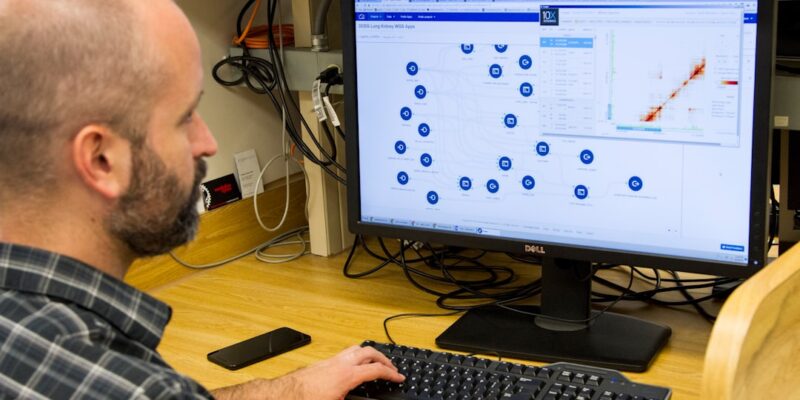
Maximizing ROI: Algorithmic Bidding in Paid Ads
Algorithmic bidding is a process in which automated algorithms are used to determine the optimal bid for an advertisement in a paid advertising campaign. These algorithms take into account various factors such as ad relevance, bid amount, and target audience demographics to calculate the most effective bid for each ad placement. The goal of algorithmic bidding is to maximize return on investment (ROI) by ensuring that ads are shown to the right audience at the right time and at the right price.
Algorithmic bidding plays a crucial role in paid advertising as it allows advertisers to optimize their campaigns and achieve better results. By using automated algorithms, advertisers can save time and effort in manually adjusting bids and analyzing data. Algorithmic bidding also enables advertisers to make data-driven decisions based on real-time performance metrics, leading to more efficient and effective advertising campaigns.
Key Takeaways
- Algorithmic bidding is a method of using machine learning to optimize bids in paid advertising.
- ROI is a crucial metric in paid advertising, as it measures the return on investment for ad spend.
- Algorithmic bidding can help maximize ROI by adjusting bids in real-time based on performance data.
- Algorithmic bidding works by analyzing data such as click-through rates, conversion rates, and cost-per-click to determine the optimal bid for each ad auction.
- Factors influencing algorithmic bidding include ad relevance, bid competition, and audience targeting.
Understanding ROI in Paid Advertising
Return on investment (ROI) is a key metric used to measure the profitability of a paid advertising campaign. It represents the ratio of the net profit generated from the campaign to the total cost of running the campaign. ROI is important in paid advertising because it allows advertisers to assess the effectiveness of their campaigns and make informed decisions about future investments.
To calculate ROI in paid advertising, you need to subtract the total cost of running the campaign from the total revenue generated by the campaign, and then divide that number by the total cost of running the campaign. The result is expressed as a percentage, which indicates how much profit was generated for every dollar spent on advertising.
Benefits of Algorithmic Bidding for Maximizing ROI
Algorithmic bidding offers several benefits for maximizing ROI in paid advertising:
1. Increased efficiency and accuracy: Algorithmic bidding automates the process of adjusting bids based on real-time performance data, allowing advertisers to optimize their campaigns more efficiently and accurately. This saves time and effort compared to manual bidding, and ensures that bids are always aligned with campaign goals and objectives.
2. Better targeting and segmentation: Algorithmic bidding takes into account various factors such as ad relevance, target audience demographics, and historical performance data to determine the optimal bid for each ad placement. This allows advertisers to target their ads more effectively and reach the right audience at the right time, resulting in higher conversion rates and ROI.
3. Improved ad performance and conversion rates: Algorithmic bidding continuously analyzes performance data and adjusts bids accordingly, leading to improved ad performance and higher conversion rates. By optimizing bids based on real-time data, algorithmic bidding ensures that ads are shown to the most relevant audience, increasing the likelihood of conversions and maximizing ROI.
How Algorithmic Bidding Works in Paid Ads
| Metrics | Description |
|---|---|
| Impressions | The number of times an ad is displayed on a webpage or app |
| Clicks | The number of times a user clicks on an ad |
| CTR (Click-Through Rate) | The ratio of clicks to impressions, expressed as a percentage |
| CPC (Cost Per Click) | The amount an advertiser pays for each click on their ad |
| Conversion Rate | The percentage of clicks that result in a desired action, such as a purchase or sign-up |
| CPA (Cost Per Acquisition) | The amount an advertiser pays for each desired action, such as a purchase or sign-up |
| Bid | The amount an advertiser is willing to pay for a click or desired action |
| Ad Rank | The position of an ad on a search engine results page, determined by a combination of bid and quality score |
| Quality Score | A rating of the relevance and quality of an ad and landing page, used to determine ad rank |
| Algorithmic Bidding | The use of machine learning algorithms to automatically adjust bids based on performance data and other factors |
The process of algorithmic bidding in paid ads involves several steps:
1. Overview of the bidding process: When an ad placement opportunity arises, the algorithmic bidding system evaluates various factors such as ad relevance, bid amount, and target audience demographics to determine the optimal bid for that placement. The system then submits the bid to the ad exchange or platform, which compares it with other bids and selects the winning bid.
2. Types of algorithmic bidding strategies: There are several types of algorithmic bidding strategies that advertisers can use, depending on their goals and objectives. These include:
– Target CPA (Cost Per Acquisition): This strategy aims to achieve a specific cost per acquisition by automatically adjusting bids based on historical conversion data.
– Target ROAS (Return On Ad Spend): This strategy aims to achieve a specific return on ad spend by automatically adjusting bids based on historical revenue data.
– Enhanced CPC (Cost Per Click): This strategy adjusts bids in real-time based on factors such as ad relevance, landing page experience, and historical performance data.
– Maximize Clicks: This strategy automatically sets bids to maximize the number of clicks within a given budget.
3. Examples of algorithmic bidding in action: For example, let’s say a retailer wants to maximize their ROI by driving online sales. They can use a target ROAS bidding strategy, which automatically adjusts bids based on historical revenue data. The algorithmic bidding system analyzes factors such as ad relevance, target audience demographics, and historical performance data to determine the optimal bid for each ad placement. By continuously optimizing bids based on real-time data, the system ensures that ads are shown to the most relevant audience, increasing the likelihood of conversions and maximizing ROI.
Factors Influencing Algorithmic Bidding in Paid Ads
Several factors influence algorithmic bidding in paid ads:
1. Ad relevance and quality score: Ad relevance is a measure of how closely an ad matches the intent of a user’s search query or browsing behavior. A higher ad relevance score indicates that the ad is more likely to be shown to the right audience and achieve better results. Quality score is a similar metric used by search engines to assess the quality and relevance of ads. Both ad relevance and quality score play a crucial role in algorithmic bidding as they influence the likelihood of an ad being shown and the cost per click.
2. Bid amount and budget: The bid amount is the maximum amount that an advertiser is willing to pay for a click or conversion. The budget is the total amount that an advertiser is willing to spend on a campaign. Both the bid amount and budget influence algorithmic bidding as they determine how much an advertiser is willing to invest in each ad placement and overall campaign.
3. Target audience and demographics: The target audience and demographics of an ad campaign play a crucial role in algorithmic bidding as they determine who sees the ads and how much advertisers are willing to pay for each click or conversion. By analyzing target audience demographics and historical performance data, algorithmic bidding systems can optimize bids to reach the most relevant audience and maximize ROI.
Best Practices for Implementing Algorithmic Bidding in Paid Ads
To implement algorithmic bidding effectively and maximize ROI in paid ads, consider the following best practices:
1. Conduct thorough research and analysis: Before implementing algorithmic bidding, conduct thorough research and analysis to understand your target audience, competitors, and market trends. This will help you make informed decisions about bidding strategies and optimize your campaigns for better results.
2. Set clear goals and objectives: Clearly define your goals and objectives for your paid advertising campaigns. Whether it’s driving online sales, increasing brand awareness, or generating leads, having clear goals will help you align your bidding strategies with your desired outcomes.
3. Test and optimize bidding strategies: Continuously test and optimize your bidding strategies to find the most effective approach for your campaigns. Experiment with different bidding strategies, target audience segments, and ad formats to identify what works best for your business.
Common Mistakes to Avoid in Algorithmic Bidding for Paid Ads
When implementing algorithmic bidding in paid ads, it’s important to avoid the following common mistakes:
1. Over-reliance on automation: While algorithmic bidding can save time and effort, it’s important not to rely solely on automation. It’s still crucial to monitor and analyze performance data, adjust bids based on real-time insights, and make informed decisions about campaign optimization.
2. Ignoring data and analytics: Data and analytics play a crucial role in algorithmic bidding as they provide insights into ad performance, audience behavior, and campaign effectiveness. Ignoring data and analytics can lead to missed opportunities for optimization and lower ROI.
3. Failing to adjust bidding strategies based on performance: Algorithmic bidding is not a set-it-and-forget-it approach. It’s important to continuously monitor performance metrics, adjust bids based on real-time data, and optimize your bidding strategies for better results.
Measuring ROI and Performance of Algorithmic Bidding in Paid Ads
To measure ROI and performance of algorithmic bidding in paid ads, consider the following:
1. Key metrics to track: Key metrics to track include conversion rate, click-through rate, cost per click, cost per acquisition, and return on ad spend. These metrics provide insights into the effectiveness of your campaigns and help you assess ROI.
2. Tools and techniques for measuring ROI and performance: There are several tools and techniques available for measuring ROI and performance in paid ads. These include Google Analytics, conversion tracking, A/B testing, and attribution modeling. By using these tools and techniques, you can gain a deeper understanding of your campaigns and make data-driven decisions.
3. How to interpret and analyze data: Interpreting and analyzing data is crucial for understanding the performance of your algorithmic bidding campaigns. Look for trends, patterns, and correlations in the data to identify areas for improvement and optimization. Use data visualization techniques to present the data in a clear and actionable way.
Integrating Algorithmic Bidding with other Marketing Strategies for Better ROI
To maximize ROI in paid ads, consider integrating algorithmic bidding with other marketing strategies such as SEO, social media, and content marketing:
1. Combining algorithmic bidding with SEO: By aligning your paid advertising campaigns with your SEO efforts, you can increase visibility in search engine results pages (SERPs) and drive more organic traffic to your website. Use keyword research and optimization techniques to identify relevant keywords for your paid ads and optimize your landing pages for better ad performance.
2. Combining algorithmic bidding with social media marketing: Social media platforms offer advanced targeting options that can be combined with algorithmic bidding to reach a highly relevant audience. Use audience segmentation and targeting features to optimize your social media ads for better results.
3. Combining algorithmic bidding with content marketing: Content marketing can support your paid advertising efforts by providing valuable content that attracts and engages your target audience. Use algorithmic bidding to drive traffic to your content and measure the ROI of your content marketing efforts.
Future Trends and Developments in Algorithmic Bidding for Paid Ads
The future of algorithmic bidding in paid ads is likely to be shaped by the following trends and developments:
1. Advances in machine learning and AI: Machine learning and AI technologies are becoming increasingly sophisticated, allowing for more accurate and efficient algorithmic bidding. These technologies can analyze large amounts of data in real-time, identify patterns and trends, and make predictions about ad performance.
2. Increased focus on personalization and customization: As consumers demand more personalized experiences, algorithmic bidding will need to adapt to deliver highly targeted and relevant ads. Advertisers will need to leverage data and analytics to understand their audience’s preferences and behaviors, and tailor their ads accordingly.
3. Integration with voice search and other emerging technologies: With the rise of voice search and other emerging technologies, algorithmic bidding will need to adapt to new ways of searching and interacting with ads. Advertisers will need to optimize their campaigns for voice search queries, as well as explore opportunities in augmented reality, virtual reality, and other emerging technologies.
In conclusion, algorithmic bidding plays a crucial role in maximizing ROI in paid advertising. By using automated algorithms to determine the optimal bid for each ad placement, advertisers can increase efficiency, improve targeting, and achieve better ad performance. However, it’s important to avoid common mistakes, continuously monitor performance metrics, and integrate algorithmic bidding with other marketing strategies for better results. With advances in machine learning and AI, as well as increased focus on personalization and customization, the future of algorithmic bidding in paid ads looks promising.
FAQs
What are algorithmic bidding strategies in paid ads?
Algorithmic bidding strategies in paid ads refer to the use of automated bidding techniques that rely on machine learning algorithms to optimize ad bids based on various factors such as ad placement, audience targeting, and ad performance.
How do algorithmic bidding strategies work?
Algorithmic bidding strategies work by analyzing data from previous ad campaigns to determine the best bidding strategy for a particular ad placement. The algorithms take into account various factors such as ad relevance, audience targeting, and ad performance to determine the optimal bid for each ad placement.
What are the benefits of using algorithmic bidding strategies?
The benefits of using algorithmic bidding strategies include improved ad performance, increased ROI, and reduced manual effort required to manage ad campaigns. Algorithmic bidding strategies can also help advertisers to reach their target audience more effectively and efficiently.
What are the different types of algorithmic bidding strategies?
There are several types of algorithmic bidding strategies, including target CPA (cost per acquisition), target ROAS (return on ad spend), enhanced CPC (cost per click), and automated bidding. Each strategy is designed to optimize ad bids based on specific goals and objectives.
What factors should be considered when choosing an algorithmic bidding strategy?
When choosing an algorithmic bidding strategy, advertisers should consider factors such as their advertising goals, budget, target audience, and ad performance. It is also important to choose a bidding strategy that aligns with the overall marketing strategy and objectives of the business.



















Can you be more specific about the content of your article? After reading it, I still have some doubts. Hope you can help me.
Thank you for your sharing. I am worried that I lack creative ideas. It is your article that makes me full of hope. Thank you. But, I have a question, can you help me?